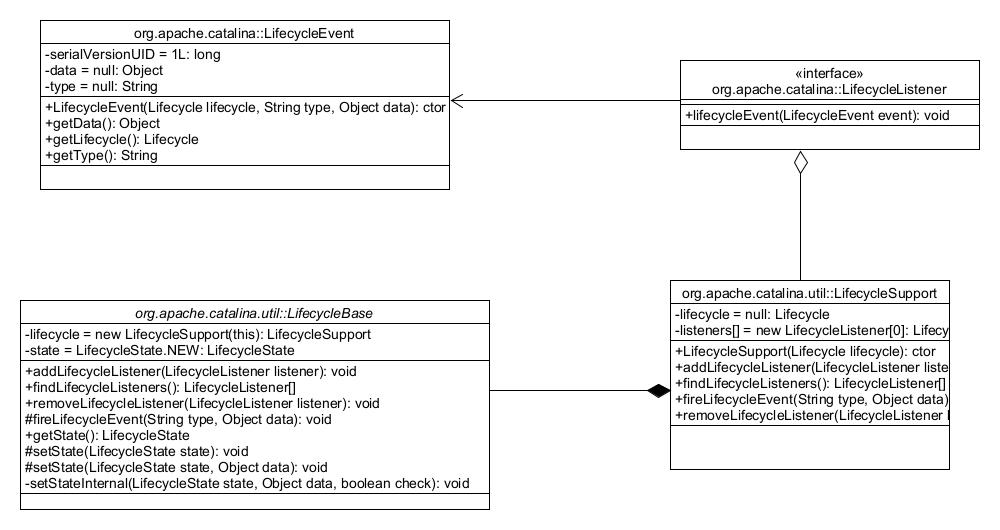tomcat源码分析(一)
摘要
在web开发过程中tomcat是一款使用率非常高的软件,tomcat作用apache顶级项目之一,采用了多种精巧的设计模式,学习优秀的代码实践有助于提升自己的代码质量。这篇文章在说明 Server 和 Service 的启动过程中,介绍了类加载器的双亲委派机制,监听器和模板方法两种设计模式,供大家一起学习。
实验步骤
tomcat 使用ant进行构建,为了便于分析使用maven管理依赖。首先使用git 拉取代码,其次导入eclipse。笔者使用jdk版本为:openjdk 11
git clone https://gitee.com/jiajinliu/tomcat70.gitEclipse 中,找到 org.apache.catalina.startup.Bootstrap 类。 在 main 方法中设置断点。启动 Tomcat 并进入调试模式。
类加载器的使用
tomcat在启动过程中,Catalina对象其这重要的作用,Catalina负责加载service.xml文件,启动Service。下面的代码展示了Catalina对象的创建过程。
Class<?> startupClass =catalinaLoader.loadClass("org.apache.catalina.startup.Catalina");
Object startupInstance = startupClass.newInstance();
// Set the shared extensions class loader
if (log.isDebugEnabled())
log.debug("Setting startup class properties");
String methodName = "setParentClassLoader";
Class<?> paramTypes[] = new Class[1];
paramTypes[0] = Class.forName("java.lang.ClassLoader");
Object paramValues[] = new Object[1];
paramValues[0] = sharedLoader;
Method method =
startupInstance.getClass().getMethod(methodName, paramTypes);
method.invoke(startupInstance, paramValues);
catalinaDaemon = startupInstance;tomcat使用类加载器实例化Catalina对象,这样实例化的原因是什么呢? 使用不同类加载器是为了避免类冲突。下面用代码说明其中的原理。 假设我们有两个版本的同一个类 MyClass,分别位于不同的 JAR 文件中: mylib-1.0.jar 包含 MyClass 的第一个版本。 mylib-2.0.jar 包含 MyClass 的第二个版本。 我们希望在同一个 JVM 中加载这两个版本的 MyClass,并且它们互不干扰。
// MyClass 版本 1.0(位于 mylib-1.0.jar)
public class MyClass {
public void printVersion() {
System.out.println("MyClass version 1.0");
}
}
// MyClass 版本 2.0(位于 mylib-2.0.jar)
public class MyClass {
public void printVersion() {
System.out.println("MyClass version 2.0");
}
}在同一个类加载器中加载两个版本的 MyClass,并尝试使用它们
import java.net.URL;
import java.net.URLClassLoader;
public class Main {
public static void main(String[] args) throws Exception {
// 创建一个自定义类加载器
URL[] urls = {new URL("file:/path/to/mylib-1.0.jar"), new URL("file:/path/to/mylib-2.0.jar")};
CustomClassLoader classLoader = new CustomClassLoader(urls);
// 加载两个版本的 MyClass
Class<?> myClass1 = classLoader.loadClass("com.example.mylib.MyClass");
Class<?> myClass2 = classLoader.loadClass("com.example.mylib.MyClass");
// 创建两个版本的 MyClass 实例
Object instance1 = myClass1.getDeclaredConstructor().newInstance();
Object instance2 = myClass2.getDeclaredConstructor().newInstance();
// 调用方法
myClass1.getMethod("printVersion").invoke(instance1);
myClass2.getMethod("printVersion").invoke(instance2);
// 演示类冲突
System.out.println("instance1 instanceof MyClass: " + (instance1 instanceof com.example.mylib.MyClass));
System.out.println("instance2 instanceof MyClass: " + (instance2 instanceof com.example.mylib.MyClass));
}
}完整代码见仓库:https://gitee.com/jiajinliu/analysis_web_server.git
Server 启动过程
Server 的启动过程中用到了如下设计模式:
监听器设计模式
接口Server的实现类是StandardService ,这个类使用Lifecycle 接口和 LifecycleListener 接口共同实现了观察者模式。通过这种方式,StandardService 可以在状态变化时通知所有注册的监听器,从而实现灵活的事件处理机制。

模板方法设计模式
在抽象类LifecycleBase中实现了接口Lifecycle的start方法,确保启动过程中的顺序,启动过程由一系列的方法组成,其中一些方法是抽象的(startInternal),需要由子类实现。子类可以通过实现抽象方法来扩展具体的逻辑,而不需要修改模板方法。

Service 启动过程
Service 的分别启动 Connector 和 Engine。在启动时使用 synchronized 加锁处理,确保在多线程环境下,StandardService 启动 Container 和 Connector 时能够安全、正确地执行。
@Override
protected void startInternal() throws LifecycleException {
if(log.isInfoEnabled())
log.info(sm.getString("standardService.start.name", this.name));
setState(LifecycleState.STARTING);
// Start our defined Container first
if (container != null) {
synchronized (container) {
container.start();
}
}
synchronized (executors) {
for (Executor executor: executors) {
executor.start();
}
}
// Start our defined Connectors second
synchronized (connectorsLock) {
for (Connector connector: connectors) {
try {
// If it has already failed, don't try and start it
if (connector.getState() != LifecycleState.FAILED) {
connector.start();
}
} catch (Exception e) {
log.error(sm.getString(
"standardService.connector.startFailed",
connector), e);
}
}
}
}
实验总结
通过阅读tomcat中 Server 和 Service 的启动过程,熟悉了类加载器的双亲委派机制,监听器和模板方法两种设计模式,使用synchronized锁确保在多线程环境下程序的正确运行。